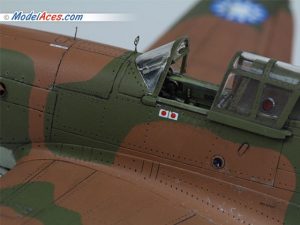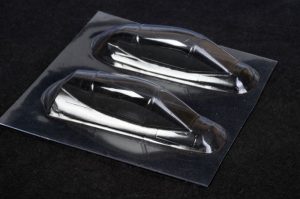When you look at a warbird, especially with the canopy open, you will notice that the cross section of the glass or plexiglass is quite thin. A detail that reduces realism in scale plastic models is the out-of-scale thickness of the clear plastic parts especially in 1/48 and 1/72 scale kits. Back in the day, modelers used to painstakingly hone out (sand down from inside) and polish plastic canopies to give them a true-to-scale thickness. Fortunately for us today, we can usually find aftermarket vacuum-formed canopies to use with our kits.

To remove a vacuum-formed canopy from its backing, start by rough cutting away the backing with a sharp pair of scissors. Next, the same as scoring parts, use a loop of tape to secure the canopy to a cutting surface so that it doesn’t move. With a new single edge razor, use a guillotine motion by first cutting with the far tip then lowering the edge down to cut away straight sections of the backing plastic. Test fit and make minor adjustment cuts as needed.

Modeling with the canopy in the open position makes it much easier to show the cockpit and instrument panel details (see accompanying P-40 image). To do this, you often need to separate the sliding hood from the forward windscreen. To make this separation cut, tape the canopy on its side with masking tape. Place the double edged razor blade as far into the canopy as possible while carefully lining up on the frame outline. Study historical photos to make sure that you are cutting to the correct side of the frame. Carefully make a guillotine-like cut starting with the far point inside the canopy. Repeat the cut on the opposite side. When both sides are cut, tape the canopy upside down and slide the single edged razor into the fresh cuts and precisely press straight down to make the final cut.
To glue the canopy in place, the two popular choices are white glue or super glue. I have not had good luck with super glue because its fumes have a tendency to frost or fog the clear canopy surface. I use white glue and after it dries, I carefully fill the bottom gap by pressing epoxy putty into it. When the putty dries, mask off the clear plastic part to protect it from scratching and carefully sand down to make a smooth seam between the canopy and the airframe. This results in an authentic-looking off-white seal.
The final step is painting the canopy. I use a couple of techniques depending on the complexity of the canopy framing. The first option is to cut thin strips of masking tape the width of the frame lines with a double edged razor. Carefully line the strips on top of the frame lines. Now mask off the remaining clear parts by putting the tape up to the edge of the clear strips. Remove the clear strips to expose the thin frame sections to be painted. The other painting option is to apply thin pre-painted strips of decal film. Paint clear decal film and cut thin, straight strips with a double edged razor.
Great article! Now if someone can direct me to a source for a replacement canopy for my Mig-15 (an OLD Hawk kit)
Thank you very much
Chris Mahon
I am in need of at least 3 F4 Phantom canopies in 1/87 scale. Are they possible to be made or have some?
Thanks!
Dirk